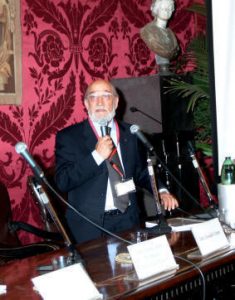
Scientific Committees. Member of the “Consiglio per le Ricerche Astronomiche” at the Italian Ministry for Universities and Research – MIUR (1991-2000), Member (from 1981); Vice-President (1991-94), and President (1994-97) of the Organizing Committee of Comm. 42 (Close Binary Stars) and of Division V – Variable Stars (1997-2000) of the IAU (International Astronomical Union); Member of the IUE (International Ultraviolet Explorer) Time Allocation Committee(1991-93), ESA, Paris; Member of the Italian Committee for the European Southern Observatory established by MIUR and by the Ministry for Foreign Affairs (1991-96, 1998-2001); Board Member of the Themis telescope from 2004. Member of IAU Commission 27 (Variable Stars), 36 (Stellar Spectra), e 42 (Close Binary Systems); Founding Member of the European Astronomical Society (EAS); Associate Member of the Royal Astronomical Society (RAS); Member of the Italian Astronomical Society (SAIt) and the Italian Physical Society (SIF).
Fellowship: McDonald Post-doctoral Fellow at the University of Texas at Austin, USA (1972).
Organisation of meetings: (as chairman or co-chairman of the Scientific Committee): IAU Colloquium no.71, “Activity in Red-dwarf Stars” (1982); Annual Meeting of the Ital. Astron. Soc. (1988); IAU Colloquium no. 102, “Solar and Stellar Flares”, 1988 (Stanford CA, USA); 1st Spectrum-UV Project Review Meeting (1990); Workshop on “Space projects to probe the internal structure and activity of the Sun and Sun-like stars” (1991); Meeting of the Eur. Astron. Soc., Solar Physics Sec. (1993), Annual Meeting of the Ital. Astron. Soc. (1995) “Verso l”Astronomia del 2000”; 4th General Meeting of the Eur. Astron. Soc. (1995) “Progress in European Astrophysics”; “Scientific Dedication of the Telescopio Nazionale Galileo”, 2000 (Canary Islands, Spain). Scientific Committee Member of several other national and international meetings in Astronomy.
Publications: He has published more than 150 articles in refereed international journals, more than 30 invited papers at international meetings and chapters for specialised books, and more than 200 contributions at national and international meetings. “Introduzione all’Astronomia”, a book (in Italian) based on lectures given as part of his University course in Astronomy.
Didactic Activity: University course in General Astronomy for students in Physics (Astrophysics section) from the academic year 1971-72. Various courses and seminars for Ph. D. students in Physics (Astrophysics section).
Research experience: Ground-based and space observations in optical and near-IR bands [at Catania, Galileo National Telescope (La Palma, Canary Islands), McDonald (Austin TX, USA), Padua, and ESO-Chile Observatories], in the far-IR (ISO satellite), in the microwave (VLA, VLBA, VLBI), in the ultraviolet (IUE satellite) and X-ray bands (SAS-2, EINSTEIN, EXOSAT, ROSAT, Beppo-SAX satellites). Advanced data reduction methods.
Principal scientific interests: Principal scientific interests. Astronomical Instrumentation; Space projects for optical, UV, EUV, and XUV bands (Spectrum-UV, UVISS, WSO); Multiwavelength studies; Physics of quiescent and active stellar atmospheres; Solar-like magnetic activity in late-type single and binary stars; Activity cycles and binary system dynamics, a field in which seminal contributions were given since his thesis work (1965) on the close binary system RS Canum Venaticorum; Stellar oscillations and magnetic fields. In order to pursue a systematic and long-term monitoring of magnetically active stars, he has also promoted the use of robotic telescopes and implemented at Catania Observatory (1989) the first robotised telescope operating outside of the USA. He recently investigated also the impact of stellar magnetic activity on the detection of planetary systems around solar-type stars and the determination of the dynamical and physical parameters of the exoplanets, collaborating to the COROT space project.
At Catania Astrophysical Observatory he founded and chaired the Group on Active Stars & System (GASS).